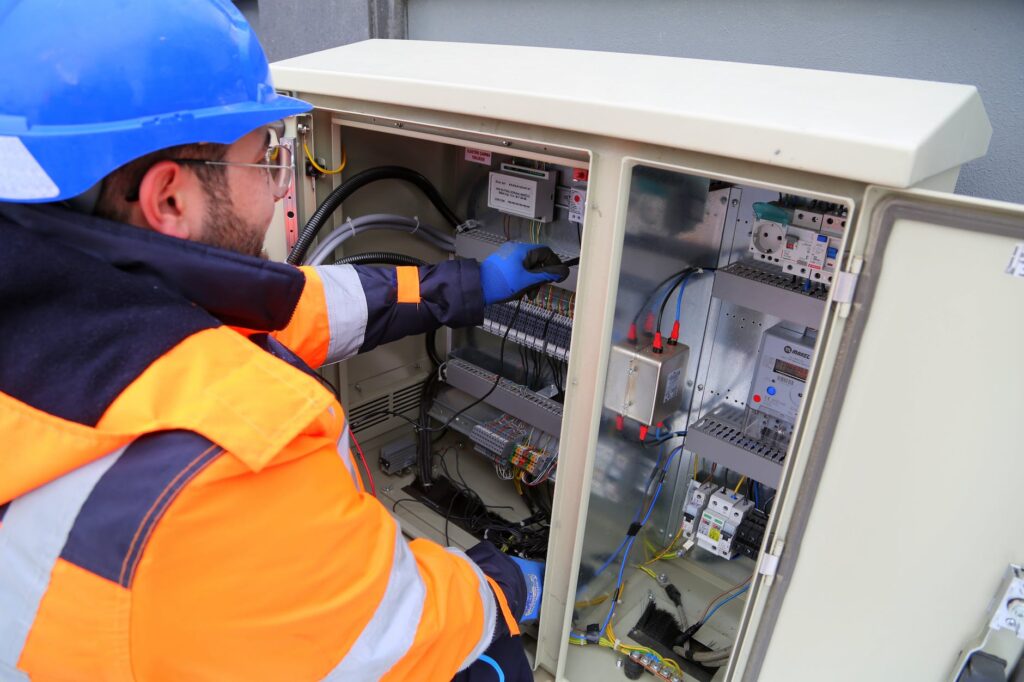A building electrical project is a detailed plan that defines how the electrical part of a building will be installed and operated. It includes the placement of outlets, switches, light fixtures, and other electrical devices, as well as specifications for wiring and protective equipment.
What is a building electrical project?
A building electrical project is essentially a map that guides the installation and operation of electricity in buildings. It is prepared by electrical engineers and considers aspects such as energy distribution, safety, energy efficiency and sustainability.
Safety and regulatory standards
Safety is a key priority in building electrical projects. Government standards and regulations, such as NBR 5410 in Brazil, define minimum safety standards that must be followed. This includes protection against electrical shock, fire prevention, and proper use of protective devices.
Energy efficiency and sustainability
Energy efficiency is increasingly important in building electrical projects. This involves using energy wisely to reduce long-term consumption and costs. Strategies such as the adoption of LED lighting technologies, automation systems for energy control and the use of renewable sources, such as panels solar panels, can improve energy efficiency and promote sustainability.
Innovation and Technology
Innovation and technology play a significant role in modern building electrical projects. New solutions, such as home automation systems and smart devices, offer greater control and efficiency in energy management. Additionally, advances in conductive materials and protective equipment contribute to improving the safety and reliability of electrical systems.
Choice of Materials and Equipment in a building electrical project
Choosing the right materials and equipment is crucial to the success of a building electrical project. This includes the selection of wires, cables, circuit breakers, switches and other components that meet the quality and safety standards established by regulatory standards. Furthermore, considerations such as durability, cost and compatibility with other technologies must be taken into account during the selection process.
Frequently asked questions about building electrical design
To start a building electrical project from scratch, the first step is to deeply understand the building's needs in terms of use and occupancy. This involves studying the architecture of the building and predict electrical energy demands. Next, it is essential to know the applicable technical standards, such as NBR 5410, which regulates low voltage electrical installation.
Drawing up a detailed diagram, including the location of light points, sockets and circuit sizing, is crucial. Furthermore, collaboration with other construction professionals can enrich the project, ensuring that it is safe, efficient and sustainable.
1. What are the important regulatory standards for building electrical design?
The most important regulatory standards for building electrical design include NBR 5410, which deals with low voltage electrical installations, offering a complete guide for the safety and effectiveness of installations.
NBR 5419, which addresses the protection of structures against atmospheric discharges (SPDA), is also crucial.
In addition to these, NBR 14039, which regulates medium voltage electrical installations, is essential for larger-scale projects.
In other words, these standards ensure that the project is aligned with the best safety and energy efficiency practices.
2. How to correctly size the circuits in a building electrical project?
The correct sizing of circuits in a building electrical project begins with the precise assessment of the electrical loads that each circuit will supply.
This includes calculating the total energy demand, considering both fixed and variable loads.
In this way, using technical standards such as NBR 5410, the necessary capacity of conductors and protective devices, such as circuit breakers, is determined to ensure that they can support the load without overheating and causing failures.
Furthermore, it is essential to foresee future expansions or modifications, opting for a safety margin that allows adjustments without major renovations.
3. What are the main challenges when designing building lighting?
The main challenges when designing building lighting include balancing aesthetic needs with technical ones, ensuring that spaces are well lit, without excesses or deficiencies.
The appropriate selection of luminaires and lamps, considering energy efficiency and visual comfort, is essential.
Furthermore, the integration of natural lighting, through strategic planning of openings, can optimize energy consumption.
Finally, compliance with safety and ergonomics standards, such as NBR ISO/CIE 8995-1, which defines the parameters for interior lighting, represents an ongoing challenge.
4. How to integrate automation systems into the building electrical project?
To integrate automation systems into the building electrical project, it is necessary to initially understand the desired functionalities, such as lighting control, climate control, security and entertainment. But, to understand better, perform the electrical designer course.
Choosing a flexible and scalable infrastructure allows the incorporation of emerging technologies. The implementation of a robust communication network, which can support the exchange of data between devices, is essential.
Furthermore, the selection of equipment compatible with market standards facilitates integration and future system updates.
5. How important is electrical grounding in buildings?
Electrical grounding in buildings is vital for the safety of occupants and the protection of equipment. It acts as a path of least resistance, directing fault or surge currents to earth, minimizing the risk of electric shock and fire.
According to NBR 5410, a properly designed and installed grounding system guarantees the effectiveness of protective devices, such as circuit breakers and fuses, by facilitating rapid operation in the event of abnormalities.
Therefore, it is crucial not only to follow technical specifications during installation, but also to carry out periodic maintenance.
6. How to ensure energy efficiency in a building electrical project?
Ensuring energy efficiency in a building electrical project involves adopting a holistic approach, which begins with architectural design, promoting maximum use of natural light.
The selection of high-efficiency equipment, such as LED lamps and low-consumption air conditioning systems, is essential. The implementation of energy management systems, which monitor and control consumption, can identify savings opportunities.
Furthermore, the integration of renewable sources, such as solar panels, contributes to reducing dependence on conventional energy sources and reduces the building's carbon footprint.
7. What is the difference between residential and building electrical design?
The main difference between residential and building electrical projects lies in complexity and scale.
Building projects cover a wider range of installations, including lighting, power, security, and automation systems, requiring a detailed analysis of energy demands and detailed planning of electrical distribution.
Furthermore, building projects often need to meet additional safety and accessibility requirements, involving coordination with other building systems, such as hydraulics and ventilation, which increases the complexity of the project.
8. How to carry out preventive maintenance of the building’s electrical system?
Preventative maintenance of the building electrical system is essential to ensure its safe and efficient operation.
It includes regular inspection of wiring, connections, protective equipment and control devices to identify and correct potential faults before they become serious problems.
Checking the integrity of the grounding system and cleaning electrical panels and components are also recommended practices.
Furthermore, monitoring energy consumption may indicate the need for adjustments or updates to the system to improve energy efficiency.
9. What are the most common mistakes in building electrical projects and how to avoid them?
The most common errors in building electrical projects include undersizing circuits, inadequate protection devices and neglect of technical standards.
To avoid them, it is crucial to carry out detailed planning, which considers all present and future electrical loads.
Adopting a conservative approach when sizing circuits and choosing protection devices, always in compliance with technical standards, such as NBR 5410, is a recommended practice.
Constant consultation with experienced professionals and continuous updating on new technologies and regulations are also effective measures to prevent errors. Therefore, to avoid possible errors, do the electrical design course.
Conclusion
It is clear that the building electrical project is not just a technical step in the construction of a building. It is, in effect, the creation of a backbone that will sustain life within these structures for decades.
Therefore, the importance of dedicating attention, care and innovation to this phase cannot be underestimated.
In other words, by illuminating the paths of modernity, building electrical projects not only provide the necessary infrastructure for everyday life, but also open doors to a more sustainable and technologically advanced future.
And so, like a lighthouse that guides ships in the night, they lead us safely through the sometimes turbulent waters of modernity.




